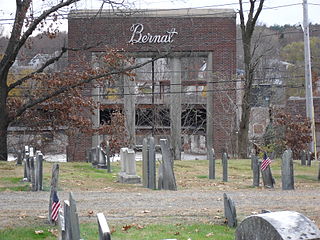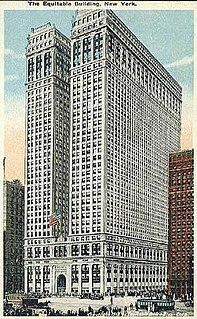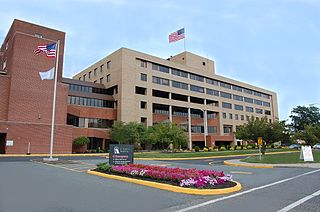
In finance, a bond is an instrument of indebtedness of the bond issuer to the holders. The most common types of bonds include municipal bonds and corporate bonds.

The Wall Street Crash of 1929, also known as the Stock Market Crash of 1929 or the Great Crash, is a major stock market crash that occurred in late October 1929. It started on October 24 and continued until October 29, 1929, when share prices on the New York Stock Exchange collapsed.

In finance, Black Monday refers to Monday, October 19, 1987, when stock markets around the world crashed. The crash began in Hong Kong and spread west to Europe, hitting the United States after other markets had already sustained significant declines. The Dow Jones Industrial Average (DJIA) fell exactly 508 points to 1,738.74 (22.61%). In Australia and New Zealand, the 1987 crash is also referred to as "Black Tuesday" because of the time zone difference.

Broad Street is a narrow street located in the Financial District in the New York City borough of Manhattan. It stretches from South Street to Wall Street.
Richard Whitney was an American financier, president of the New York Stock Exchange from 1930 to 1935. He was later convicted of embezzlement and imprisoned.

Pendleton Woolen Mills is an American textile manufacturing company in Pendleton, Oregon, United States. It is known for its blankets and woolen clothing.

Pacific Brands Underwear Group, known under its core brand Bonds, was an Australian manufacturer and now a importer of men's, women's and children's underwear and clothing, and a subsidiary of Pacific Brands. The head office is located at 115 Cotham Rd in Kew, Melbourne.

Hanes and Hanes Her Way are brands of clothing currently owned by the HanesBrands.
Botany 500 is a brand of menswear and suits that was originally part of a firm based in New York City. The name lives on today as a licensed property by several foreign clothing manufacturers.

The Bernat Mill, also known as Capron Mill, and later Bachman Uxbridge Worsted Company, was a yarn mill in Uxbridge, Massachusetts, USA, that was for the most part destroyed by fire on July 21, 2007.
The Segal Lock and Hardware Company of Manhattan, New York, was a leading manufacturer of hardware merchandise and razor blades in the 1920s and 1930s. Established in Connecticut and Manhattan, the firm relocated to Brooklyn, New York, in the mid-1920s. The Segal Safety Razor Corporation was a subsidiary of the Segal Lock and Hardware Company. The business was at first known as the Burglar-Proof Lock Company.
Holeproof Hosiery was a Milwaukee, Wisconsin textile firm that was founded in 1901. The business was built primarily through earnings which were left to aggregate in the company. Its advertising expenses exceeded $500,000 after 1901, making it a brand name recognized worldwide. The business produced men's and women's hosiery, underwear, lingerie, and men's pajamas. From 1916 - 1925 Holeproof Hosiery sales increased from $2,037,000 to $9,220,000. Net sales totaled $24,435,342 in 1954.
Legnam Corporation operated 132 general merchandise stores in 38 of the United States prior to becoming insolvent in June 1932. It sold ladies' apparel. Owing to the financial crisis during the Great Depression, the chain store, formerly known as Mangel's, became unable to pay its debts. The company maintained offices at 1115 Broadway and 226 Main Street in Paterson, New Jersey.

The G.R. Kinney Company was an American manufacturer and retailer of shoes from 1894 until September 16, 1998. Its listing on the New York Stock Exchange, symbol KNN, began in March 1923. The shoe concern was started by George Romanta Kinney whose father ran a general store in rural Candor, New York. The father became indebted and George vowed to repay his indebtedness. In 1894, at the age of 28, he had saved enough to purchase a Lester retail outlet in Waverly, New York. Kinney succeeded by selling affordably priced shoes to working Americans.
Weber & Heilbroner was a Lower Manhattan men's clothing company of the 20th century. In August 1909 the clothier leased office space in the Seymour Building, 503 Fifth Avenue. The corporation is noteworthy because of its importance to New York City consumers over a number of decades. As of 1937 the retailer was a wholly owned subsidiary of Allendale Corporation.
Edgar Lawrence Smith was an economist, investment manager and author of the influential book Common Stocks as Long Term Investments, which promoted the then-surprising idea that stocks excel bonds in long-term yield.

The 1926 Passaic textile strike was a work stoppage by over 15,000 woolen mill workers in and around Passaic, New Jersey, over wage issues in several factories in the vicinity. Conducted in its initial phase by a "United Front Committee" organized by the Trade Union Educational League of the Workers (Communist) Party, the strike began on January 25, 1926, and officially ended only on March 1, 1927, when the final mill being picketed signed a contract with the striking workers. It was the first Communist-led work stoppage in the United States. The event was memorialized by a seven reel silent movie intended to generate sympathy and funds for the striking workers.

The Dundee Canal was an industrial canal in Clifton and Passaic in Passaic County, New Jersey. It was built between 1858 and 1861 and ran parallel to the Passaic River. It supplied hydropower and water for manufacturing. There was interest by some members of the business community to modify the canal to support navigational uses, but the canal was never used for that purpose.
Ellen "Nellie" Dawson Kanki, best known as Ellen Dawson, was a Scottish-American political activist and trade union organizer in the textile industry. Dawson is best remembered as an active participant in three of the greatest textile strikes of the 1920s; the 1926 Passaic textile strike, the 1928 New Bedford textile strike, and the 1929 Loray Mill strike in Gastonia, North Carolina. An activist in the Communist Party USA during the 1920s, Dawson was the first woman ever elected to a leadership position in an American textile union.

The Continental Bank and Trust Company of New York was a financial institution based in New York City, New York, United States. It was established in 1870 as the German-American Bank, which became the Continental Bank of New York. Originally in the Equitable Building at 120 Broadway, the bank was later headquartered at 50 Wall Street, 25 Broad Street, and starting in 1932 the Continental Bank Building It became known as the “brokers bank” for its collaboration with Wall Street brokers and investment banking interests. The institution was renamed the Continental Bank and Trust Company of New York around 1929, at which point it was involved in extending its business with acquisitions of commercial banking and fiduciary operations. Acquired banks included the Fidelity Trust Company in 1929, International Trust Company and Straus National Bank and Trust Company in 1931, and Industrial National Bank later that year. In 1947, the bank earned $804,000 in net profits. As of December 31, 1947, Continental had total resources of $202,000,000, and deposits of $188,000,000. It merged with the Chemical Bank and Trust Company in 1948.

















